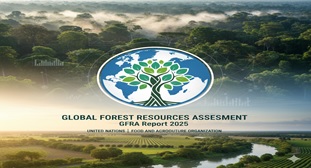08 December, 2025
Global Forest Resources Assessment (GFRA) 2025
Thu 23 Oct, 2025
Reference:
- The Global Forest Resources Assessment (GFRA) 2025 report was released by the Food and Agriculture Organization (FAO) of the United Nations during the Global Forest Observation Initiative (GFOI) Plenary 2025 in Bali. The report provides a comprehensive overview of the status and trends of forest resources in 236 countries and territories from 1990 to 2025.
Key Points:
- The report supports Sustainable Development Goals (SDGs) such as SDG 15.1.1 (proportion of forest area to total land area), SDG 15.2.1 (progress in sustainable forest management), and SDG 15.4.2 (mountain green cover index).
- It also aligns with the Paris Agreement, the Kunming-Montreal Global Biodiversity Framework, and the UN Forest Strategy 2017-2030.
- New features in FRA 2025 include interactive online databases, API access, and country-specific PDF reports.
Global Forest Area and Extent:
| Parameter | Value (2025) | Notes |
| Total Forest Area | 4.14 billion ha | ~32% of global land area, 0.5 ha per person; ~50% of forests are in tropical regions |
| Naturally Regenerated Forest | 3.83 billion ha (92% of total) | Decline of 324 million ha from 1990 to 2025 |
| Primary Forests (natural, unchanged) | 1.18 billion ha (~1/3 of total) | Loss rate halved compared to early 2000s |
| Planted Forests | 312 million ha (8% of total) | Increase across all regions since 1990, but global growth rate slowed recently |
| Growing Stock | 630 billion m³ | – |
| Forest Carbon Stock | 714 Gt | Recorded an increase |
- Forest area appears stable, but loss of natural forests continues.
- Growth in planted forests is positive, reflecting restoration efforts (e.g., tree transformation).
- Decline in naturally regenerated forests poses a threat to biodiversity and ecosystem services.
Deforestation and Afforestation Rates:
- A major finding of FRA 2025 is that global deforestation has slowed, but forests are still under pressure.
- Net forest loss: Decreased from 10.7 million ha/year in the 1990s to 4.12 million ha/year during 2015–2025.
- Deforestation rate: Declined from 17.6 million ha/year (1990–2000) to 10.9 million ha/year (2015–2025).
- Forest expansion rate: Declined from 9.88 million ha/year (2000–2015) to 6.78 million ha/year (2015–2025).
Regional Trends:
| Region | Key Trends |
| Africa | Significant loss of naturally regenerated forests; deforestation slowed but remains high |
| South | America Decline in natural forests; highest loss in the past decade |
| Europe | Increase in naturally regenerated forests; positive management |
| Asia | Growth in planted forests; tropical regions under pressure |
| North America & Others | Stable, but threatened by climate impacts |
Forest Management Practices:
- Forests under long-term management plans: 2.13 billion ha (55% of total), increased by 365 million ha since 1990
- Forests in legally protected areas: 813 million ha (20% of total), increased by 251 million ha since 1990
- Ownership: 71% public, 24% private
Management Objectives:
- Production: 1.20 billion ha (29%)
- Multiple-use: 616 million ha
- Biodiversity conservation: 482 million ha
- Soil and water conservation: 386 million ha
- Social services: 221 million ha
Key Findings for India:
- Improved global ranking: India moved from 10th to 9th position in total forest area, with approximately 72.7 million ha of forest cover.
- Annual forest area gain: India ranks third globally in annual forest area increase, recording 1.91 lakh ha per year (2015–2025).
- Factors behind success: According to the Ministry of Environment, Forest and Climate Change, progress reflects the success of government policies and community-led initiatives, including Green India Mission, CAMPA, and the National Afforestation Program (NAP).


















